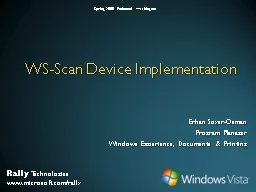

Erhan SoyerOsman Program Manager Windows Experience Documents amp Printing Presentation Overview Windows Rally and Web Services on Devices Overview Scan Service Definition Version 10 Review WSD Scan class driver ID: 395653
Download Presentation The PPT/PDF document "WS-Scan Device Implementation" is the property of its rightful owner. Permission is granted to download and print the materials on this web site for personal, non-commercial use only, and to display it on your personal computer provided you do not modify the materials and that you retain all copyright notices contained in the materials. By downloading content from our website, you accept the terms of this agreement.
Slide1
WS-Scan Device Implementation
Erhan Soyer-Osman
Program Manager
Windows Experience, Documents & Printing Slide2
Presentation Overview
Windows Rally and Web Services on Devices
Overview Scan Service Definition Version 1.0
Review WSD Scan class driver
DemoSlide3
What is Web Services on Devices?
Defines how devices use web servicesSlide4
Where does WSD Fit in ? Slide5
Roadmap
Windows
Ver. xx.x
Continued Investments in WSDSlide6
WS-Scan and PWG
Microsoft and Xerox collaborate to contribute WS-Scan to Print Working Group (PWG), a program of the IEEE
Enable industry wide standardization of networked multifunction device behaviors
Contributions will be reflected in the PWG Semantic Model of network behaviors and capabilities for multifunction devices
http://www.microsoft.com/presspass/press/2008/may08/05-29WebServicesPR.mspx
Slide7
Purpose of Scan Service
Scan Service Specification describes the operational model for network connected scanning devices
Scanning model is focused primarily on capturing a document and delivering it to a destination client
Operations/Events in WS-Scan v1.0 are more specific to consumer devices scenarios
Proxy is considered inbox for Windows Vista operating systems
Built on Web Services for Devices (Devices Profile for Web Services), Windows PnP-X supportSlide8
Functional ModelSlide9
Functional Model:Job Setup
Job Setup is provided by a client. The client determines the capabilities of the devices and an interface to allow users to choose scanning options
Client creates scan ticket that specifies the scanning parameters of the user and will be used during Job ExecutionSlide10
Functional Model:Job Execution
Physical Scan and generation of data
Uses the scan ticket defined in job setup to define the parameters of job execution
Can be either Device or Client initiated (client sends a request to scan device)Slide11
Functional Model:Data Transfer
Movement of data from device buffer to destinationSlide12
Usage ScenariosScan to Workstation, Device Initiated
A user wants to scan a document to his PC, places documents on platen and selects scan configuration preferences. The user presses the ‘Scan’ button
Device Notification of waiting scan (
ScanAvailableEvent
)
Client initiated Execution (submits
CreateScanJob
operation)Slide13
Usage ScenariosScan to Workstation, Client Initiated
A user wants to scan a document to her PC, places documents on platen and uses UI hosted by a client that is near the device to select scan configuration preferences. The user presses the ‘Scan’ button from the client UI
Client initiation Execution (submits
CreateScanJob
operation)Slide14
Service Schema
Scanner, Job and Document elements are grouped together in logical elements
Example:
Scanner
Description
Contains descriptive information that is static per device or set by a control point
DescriptionFor Jobs and Documents contains descriptive information that is administratively set or supplied by a control point during job submissionSlide15
Service Schema
ScannerDescription
Elements contain a description of the Scanner
i.e.
ScannerName
,
ScannerInfo, ScannerLocation
ScannerDescription
ElementsScan Service Definition Model v1.0Slide16
WS-Scan Activity DiagramJob Setup
Web Service Operations:
GetScannerElements
ValidateScanTicketSlide17
WS-Scan Activity DiagramJob Execution & Data Transfer
Web Service Operations:
CreateScanJob
RetreiveImage
Web Service Events:
ScanAvailableEvent
(Device
Initiated)
JobEndStateEventSlide18
WSD Scan Class DriverFeatures
Windows Vista has inbox mini-driver for WS-Scan supported devices
WIA v2.0, compatible with TWAIN (WIA-TWAIN Compatibility Layer)
Uses Scan Service Definition Version 1.0, Web Services on Devices
IHV does not need to provide a separate scan driverSlide19
WSD Scan Class Driver
ReadSlide20
Demo
Using
EPSON
PM-T960
Windows Vista
WSD Scan class driver
Rally components:WS-ScanDPWS/WSDPnP-XSlide21
Common Questions
Device is able to stream data to client - not required to buffer full image at once (for applicable image formats)
Device does not need to support all WIA required formats. i.e. MUST support one of Portable Network Graphics (PNG), EEXIF – only for 24-bpp RGB data, Single-page uncompressed TIFF or Windows DIB.
WSDScan
class driver will perform conversion for devices
Devices that do not use
WSDScan class driver may send proprietary stream which is later converted on client into WIA required formatsSlide22
Call to Action
Implement WS-Scan in network connected devices
Resources:
http://www.microsoft.com/whdc/connect/rally/wsdspecs.mspx
prninfo@microsoft.com
Take advantage of Rally better-together scenarios i.e. WSD Print, WSD Scan, PnP-X, WCN/WPS, WSD Scan
class driverSlide23
© 2006 Microsoft Corporation. All rights reserved. Microsoft, Windows, Windows Vista and other product names are or may be registered trademarks and/or trademarks in the U.S. and/or other countries.
The information herein is for informational purposes only and represents the current view of Microsoft Corporation as of the date of this presentation. Because Microsoft must respond to changing market conditions, it should not be interpreted to be a commitment on the part of Microsoft, and Microsoft cannot guarantee the accuracy of any information provided after the date of this presentation.
MICROSOFT MAKES NO WARRANTIES, EXPRESS, IMPLIED OR STATUTORY, AS TO THE INFORMATION IN THIS PRESENTATION.